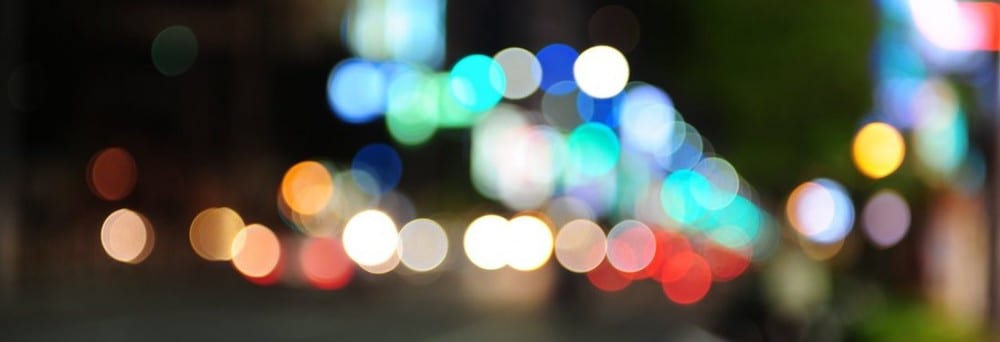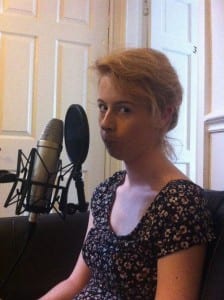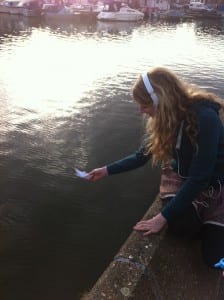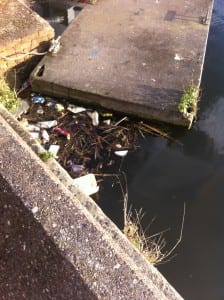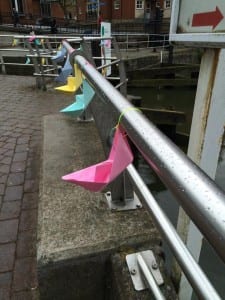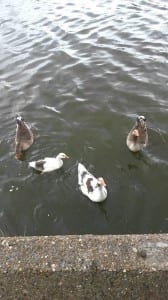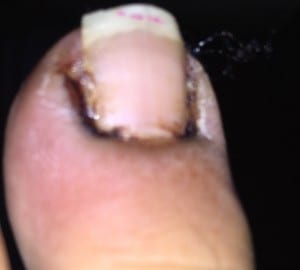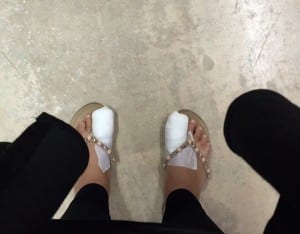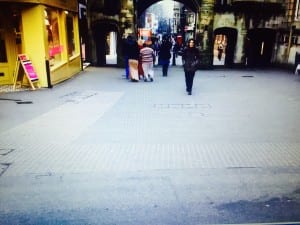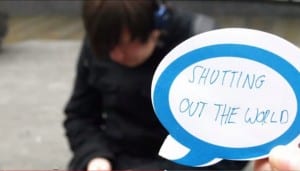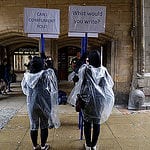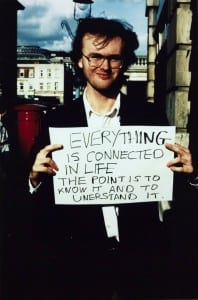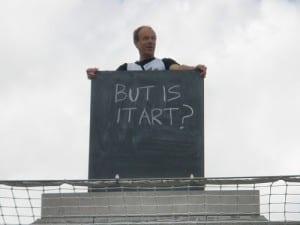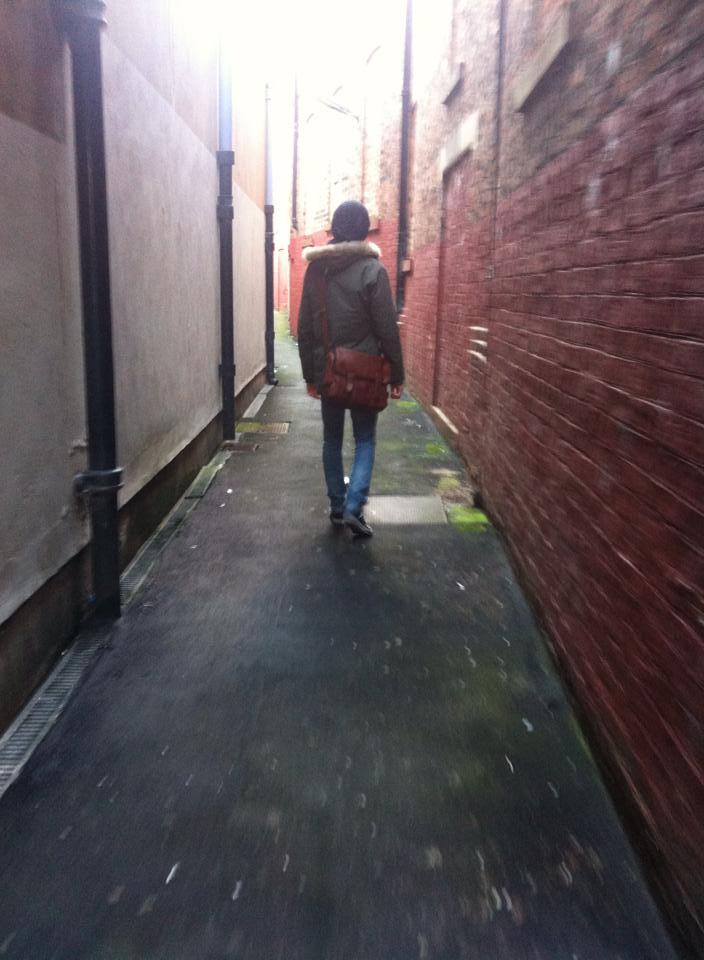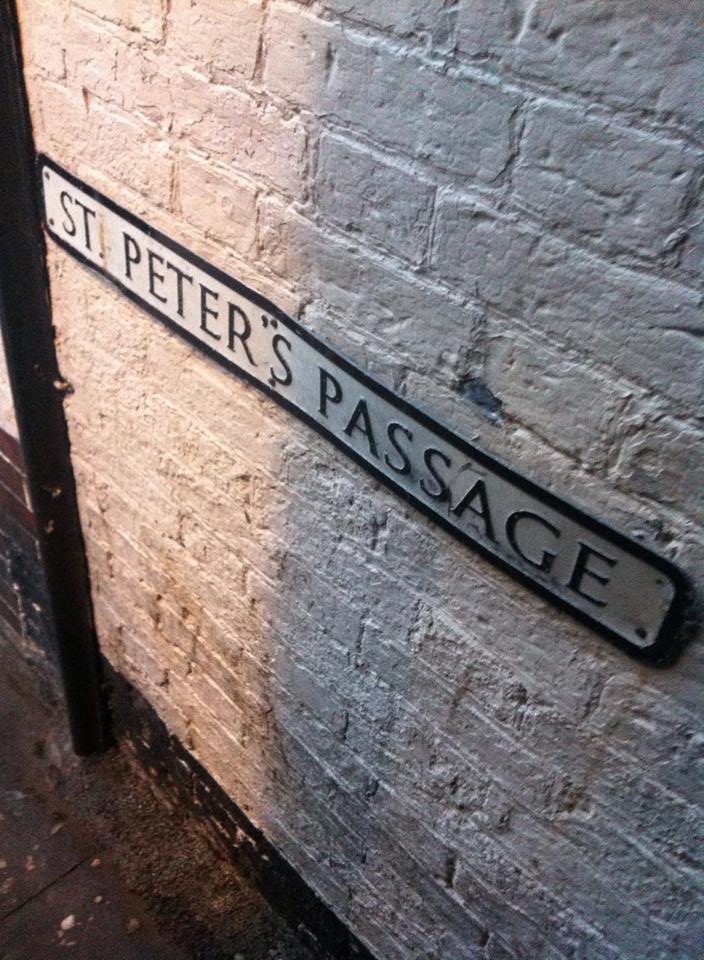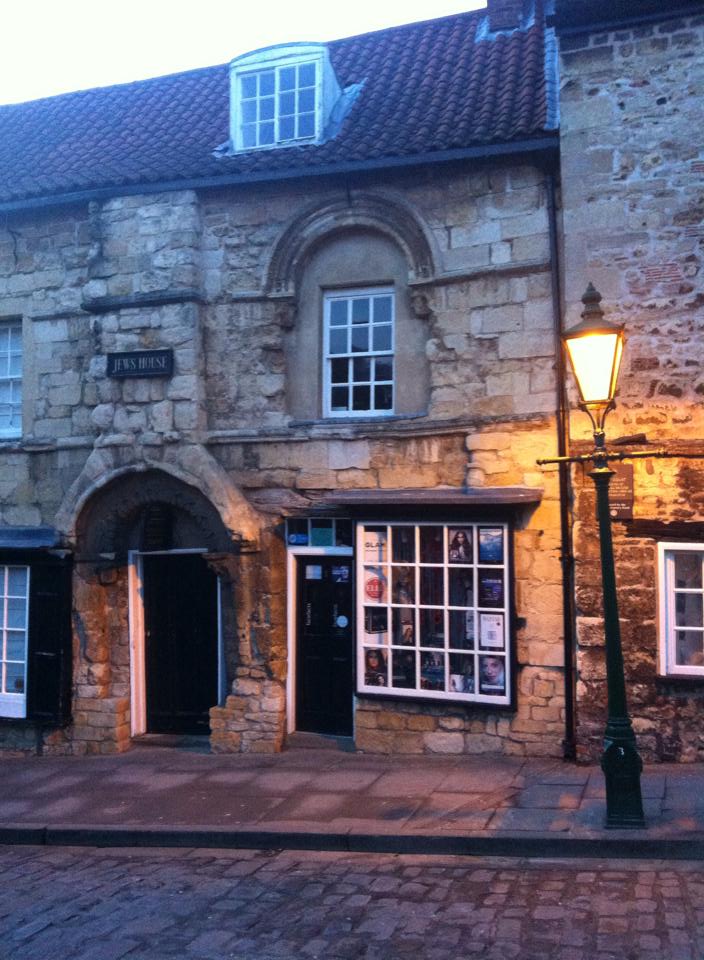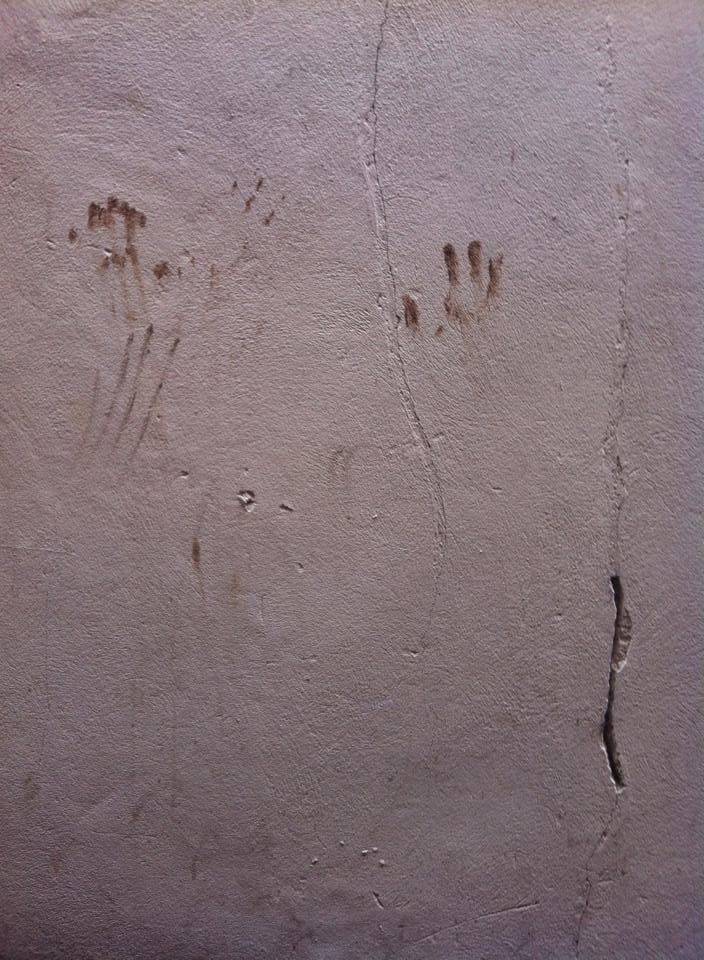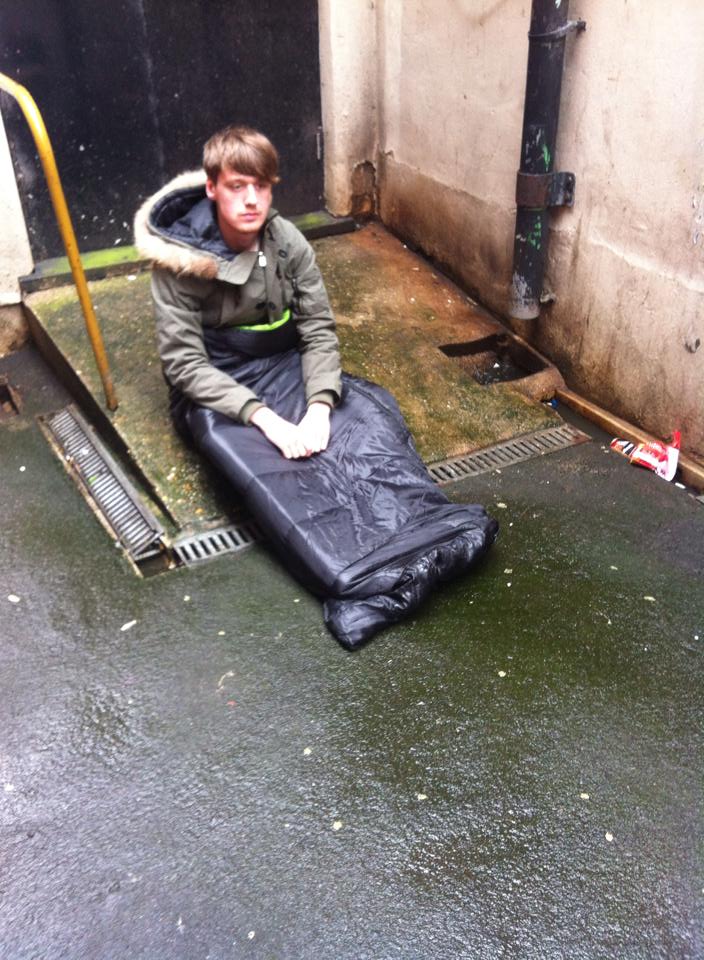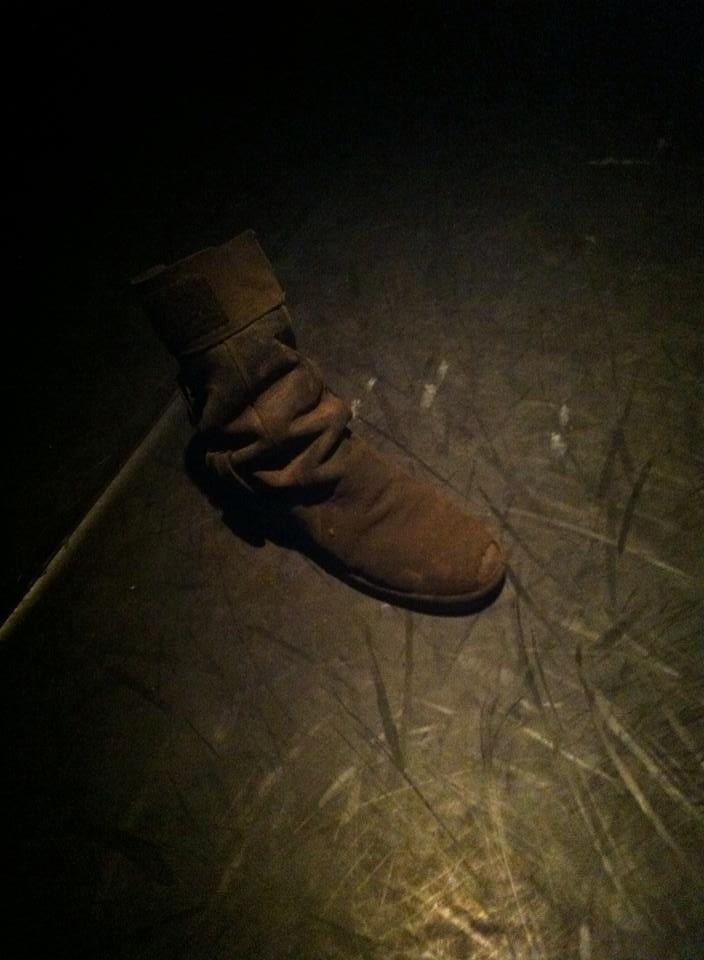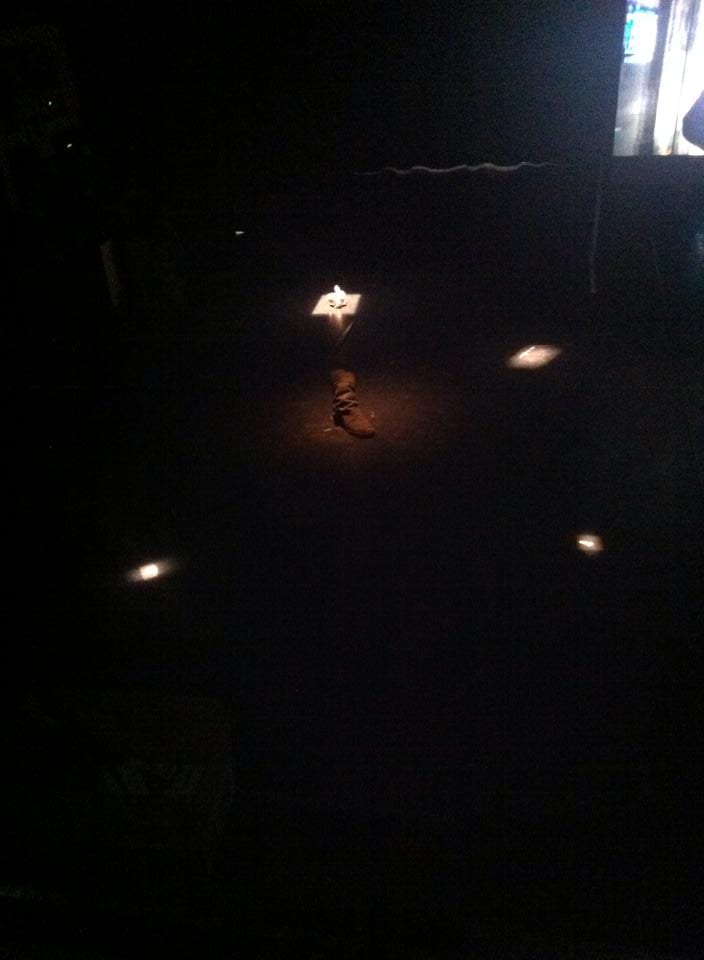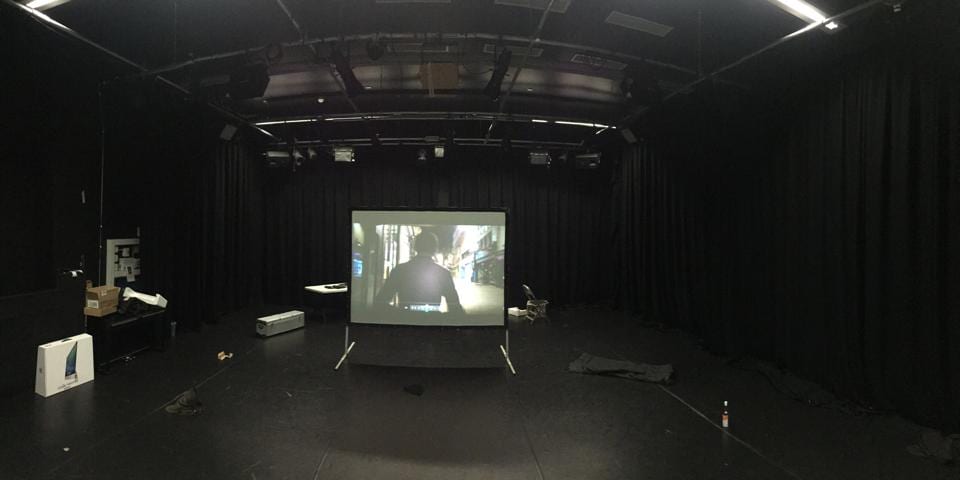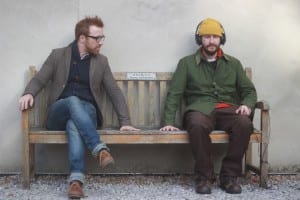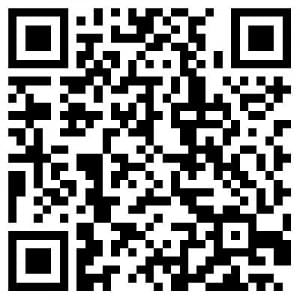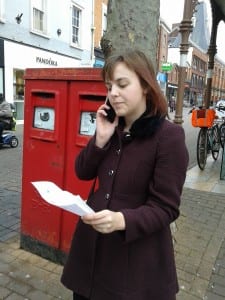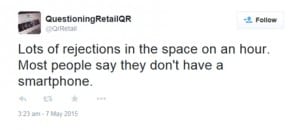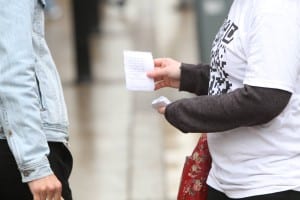Frequencies is one of six Blogs by students on the School of Fine and Performing Arts’ Site Specific Performance Module. Second Year Drama students engage with performance that takes place outside the traditional venue of a Theatre and which is designed with a particular place in mind. The Frequencies group is proud to be working with http://thresholdstudios.tv/ to develop performance work on Lincoln’s High Street and Brayford Waterfront for possible inclusion in FREQUENCY 2015 -the city’s biennial festival of digital culture. Student work will be performed in early May, and work chosen for inclusion in FREQUENCY 2015 will be developed for the festival in October.
Against the Flow – Final Blog Submission
A new way of thinking
“Site-specific performance engages with site as symbol, site as a story-teller, site as a structure” (Pearson, 2010) In order to create and perform a truthful and unique performance it was necessary to understand what Site-specific is; I had to consider not only how to connect with a site but how to make that site connect on a new level with an audience. Using a place as a performance space requires research and time; I felt it was important that I personally understood the depth of the history of the site so I could then get an audience to have that same personal connection. Research into different ideologies and explanations relating to Site-specific performance eventually enabled me to come to my own conclusion about what it was.
My understanding of Site-specific is that it is a performance held in unique public locations which invite the audience to connect with something they would normally take for granted. Armed with this basic understanding, my group began to assemble the task by combining our choice of location with the themes of liberation and technology. We opted to perform our work on Brayford Wharf as it was a site we knew little about despite walking on it almost every day. Water and technology may be regarded as being incompatible so, I wanted to find a way to make them harmonious since technology is very much part of our culture and a robust form of communication. We decided to create an audio experience for our audience which would communicate the origins of the waterfront and how it has been manipulated over time. To inform our performance, the group were inspired by works such as “Ports Of Call”-Toby Butler, “The Carrlands project” – Mike Pearson, “Sit with me and remember” – Michael Pinchbeck and “Our Broken Voice” – Artist Collective Circumstance. We each took time to listen and think about how these successful audio performances were structured, spoken and how the site was re-imagined. I was enthused by these and found they creatively helped in the production of our final performance “Against the Flow”; they gave me an insight into how a successful audio tour is composed using a script, the spoken word, atmosphere and its connection to the physical world. Merely having audio and a location however, would not be enough; we wanted the audience to have moments of physical contact with the site so we took inspiration from the Brayford itself, the wildlife in and around it and the assorted boats. We felt our participants would enjoy placing their own mark on this site in different ways so first, they would watch a paper boat being constructed, secondly they would feed the local wildlife and finally, be given a paper boat to launch in the water. They would do all this whilst walking in the opposite direction to the flow of the water hence the title “Against the Flow”.
Refection’s in the Water
Creating a site specific performance was not a process that came naturally to me and I initially found myself confused and fumbling around for inspiration. The problem I faced was not knowing how to communicate with a site ie Brayford Warf, in order to craft a well-rounded performance. The decision to use the waterfront to stage our performance came from our desire to unlock the secrets this waterway may hold, and how this seemingly unchanging pool of water has being moulded and reinvented over time. I felt a good starting point for me would be to visit the site and study everything from its surroundings to the different angles of the water and how that change of view altered my perspective. I tried to look beyond its everyday familiarities and notice the undetected details in and around the water; then I started to see the way the current changed and how this affected the waves, how the smallest change in light affected the water’s atmosphere and my feelings towards it. I even began to notice the walls and buildings and how they shaped and dominated this small natural haven. To enable an audience to see these little details and how the ugly and beautiful work together in one space, the group needed to learn everything about our site. As we began researching the Brayford Pool, we uncovered a variety of first hand accounts dating back to the 18th century; these offered us an insight into how the buildings surrounding the waterway have developed over the years. “The buildings opposite the car park facing Water Lane are also due for demolition and the site is to be used for redevelopment.” (Creasey, 1967).
Despite our research using the internet and local archives, there was little helpful information and we did not want to just focus on historical facts as it would be impossible to truly connect with our site this way. Instead, we needed to have a personal connection with the location that would animate our final performance; a connection we could pass on to the audience. The group spent some time thinking about water and the happy memories it evoked so, on a visit home, I went for a walk around my local lake for inspiration; it was there that happy memories were re-kindled. “In Britain there is no wilderness, no untouched natural landscape. Every metre is the product of human intervention” (Pearson,2010,93). When walking along the Brayford waterfront it is easy to see how human interference has shaped and changed the environment into what it is today. This once open area of water has decreased in size and depth as humanity has grown and added to it. With this in mind, I found myself at Newmillerdam remembering how this very familiar manmade expanse of water had changed over the last 20 years and its similarity to the Brayford. I have been visiting this dam my whole life and have many emotional connections with the area however, it was on this last visit that my whole perspective was changed. I took the same old path and breathed in the fresh air which my mother always advocated would ‘clear the mind and help with unwell feelings’ despite the fact it was always cold and windy. As I approached the water’s edge however, I found myself transported back to Lincoln; the colour of the water, the smell, the swans, the wildlife and the ripple in the waves was practically identical; the only difference was the surroundings. It was at this point that the sun broke through the clouds and made the water shimmer and, just for a second, the memories of the most important man in my life, my grandfather, came flooding back. I spent many a happy day at this location with him, feeding the ducks, searching for frogs and just enjoying the water as a whole however, as I stopped reminiscing, I realised that this memory connection with the water does not have to be restricted to an actual place. If what you are observing has every attribute of what you can remember, who is to say you cannot transport that memory to your current location and relive the happy emotions in a new place. If water is ever changing, then you could be looking at water from that memory and not even recognise it.
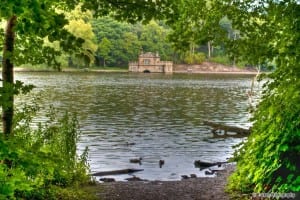
http://static.squarespace.com/static/50f09dcae4b0a42e43ea565e/50f09f1ee4b0e9eeb39bf889/50f09ff8e4b0e9eeb39c110b/1357946872264/NewMillerDam-2.jpg?format=original
As promised, the fresh air had cleared my mind and I found the link I needed to take with me to my site performance. Even though this was not Brayford Warf, their similarities were tangible and invoked strong feelings which could easily come through in our performance. I realised then how important it is to work in a space other than the theatre; you never know who will participate and if they are connected to the place yet the performance must respect its physical and unseen history. “the work of site-specific performance is not to excavate the hidden truth or essence of a location but instead to activate the inherent multiplicity of site”(Theron, 2012, 279).
Music to my Ears
Our most important group decision was that we wanted our final piece to be an audio experience; for the performance to be more intimate; a casual conversation that draws the audience closer to our site through our combined voices. This would be more enthralling and delicate for the participant, and would give them the opportunity to make their own connection with our guidance. With audio now being the key point of focus, we began researching different practitioners and previous performances that would help us successfully create an audio tour; my area of research was the Carrlands Project by Mike Pearson. This audio tour was based around a series of 3 compositions that take you on a journey through North Lincolnshire’s Ancholme Valley. I listened intently to how this particular piece was structured and how the balance between sounds and spoken text was achieved. I found this particular piece dark with an uneasy atmosphere, but the other group members had different experiences with Ports of Call – Community Project and Sit With Me For A Moment And Remember – Michael Pinchback. Their contrasting views were helpful when deciding how we wanted the final performance to feel to the audience. To give authenticity to the piece, we decided to use real life stories by Ron Dadswell, an experienced sailor, and incorporate the sound effects of natural flowing water in between the spoken text so the participant would have quiet moments to reflect upon the whole experience.
(Mudd, 2015)
Crafting Letters
Unfortunately, due to some personal issues, I had some periods of absence when I could not be with the group when they were constructing the script however, I always maintained contact and kept myself involved by having the script sent to me to add to and look over. I undertook my own research on the internet and in my local library and, when I returned to university, I was able to understand the script’s progress. My group found it difficult to structure the text in a way that was informative yet conversational, so we turned again to previous work for inspiration. A Hackney 4th of July By Conan Lawrence and Mark Hunter really helped us to improve the way we could give informed instructions through audio; we paid close attention to the way in which they spoke to the audience; it was as if we were stood beside them. I personally learnt that it was not just the way you structure the words on paper, but about how you actually speak and record those words to make the history come to life in the participants’ eyes. We also found it useful to incorporate some nautical language into our text as it reinforced the connection with the water when describing the land around it.
Speaking a foreign language
Having completed our script for ‘Against the flow’, it was time to create the first draft recording of our audio experience. Taking the microphone, I felt completely unfazed about the task ahead of me; we had a script, the equipment and therefore the voiceover should be a breeze. I was in for a very big surprise. The first challenge I encountered was actually speaking the written text; some of the sentences were poorly composed and the structure was clearly wrong so, as a group, we sat down and rewrote the text as I spoke it through in order to correct our mistakes. Another challenge I encountered was with my Yorkshire accent because, when we listened to the recording, we found some sections had loud rushes of wind and sharp vocals that only occurred because of my way of pronouncing B and P; this was particularly problematic when the water I was constantly referring to throughout the piece was the Brayford Pool. The biggest challenge I faced however, was how to present my vocals on the recording. The purpose of our piece was to change the audiences’ perception of the waterfront by offering them an alternative perspective on it that they had probably never considered. This could be completely ruined by the wrong representation of the voice. My first attempt at the recording sounded like a storybook or a relaxation tape not an immersive and informative piece so, taking this on board, I listened to and researched a variety of audio tours in order to better understand how to improve the quality of my voice for our performance. “Walking accompanied by the taped stories that capture and recall events that happened at specific places in the city, creates an opportunity to see and interrogate the city as a chronotope, charged with traces of the past, personal experiences, affective qualities, and social regimes” (Hahn, 2014, 29) ‘50 Kilometres of Files’ by Haug, Kaegi and Wetzel is an audio walk that was created by Rimini Protokoll and takes place in central Berlin. What I found most fascinating about this performance was, that despite the fact it was spoken in German, which I did not understand, the way in which the people were speaking made me realise that it is not necessary to stage a descriptive voice in order for the piece to be interesting. It is more effective if you speak naturally because the listener then gets a stronger sense of the raw emotion of the piece. It was very obvious just from the tone of the voice when the text was serious, sad or happy and when they wanted the listener to feel part of the history of a place. Emotionally, there was no language barrier and it gave me something to think about when trying to create this personal vocal and audio connection in our Piece. If people who do not understand the language yet can understand the emotions then it opens up the experience and its accessibility. I was also inspired by two very different audio tours namely ‘Our broken voice’ by Artist Collective Circumstance (Dovey and Fluemont, 2012) and ‘The Carrland’s Project’ by Mike Pearson (Pearson, 2007). These audio tours confirmed just how important the voice is as both were targeting a different emotional response. In ‘Our broken voice’ the listener is made to feel quiet, unsafe and excited as these adrenaline fired feelings bring the story to life. ‘The Carrland’s Project however, produced feelings of fear and uncertainty that took the listener into the depths of the history where every step became cautious and real. From these, I realised that the group needed to decide what kind of atmosphere and emotions we wanted to convey to our audience so the right voice would be used; our final decision was for it to be relaxed and enjoyable.
Kerry McCarthy (2015) Against the Flow. [Performance] Lincoln: 74 Newland Street West, 20 March.
Testing the Waters
The 27th of March 2015 was the test run of our first recording of ‘Against the flow’. Naomi and Rachel listened to the audio whilst I walked the course, acting out the place of each person within the piece that the audience would encounter. I found the test run extremely useful as it gave me an insight into how the piece would work whilst interacting with the site. The end of the piece required some modifications such as we needed a bigger gap to walk from the central point to the end point as the audio was ahead of us. We also found that when launching the paper boat, the area we chose caused it to float into a collection of rubbish because of the wind direction thus ruining the poetic ending we intended. Thankfully, the audio could be easily edited, but the wind’s effect on the water was not something we could ever predict.
Rachel Mudd and Paper Boat (2015) Against the Flow. [Performance] Lincoln: Brayford Wharf, 27th March.
Paper Boat (2015) Against the Flow. [Performance] Lincoln: Brayford Wharf, 27th March.
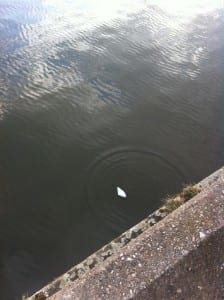
Paper Boat (2015) Against the Flow.[Perfromance] Lincoln: Brayford Wharf, 27th March.
I also discovered that I needed to be very patient as it often took quite some time for the participator to arrive at my allocated area. As a result, I had to stay in a natural performance state no matter how long it took and be ready when the audience arrived to make my contribution to the piece as meaningful as all the others had. I recognised the need to over-feed the wildlife in order to ensure there was always a group of birds around throughout the day; without this temptation, there was the possibility that there may well be no ducks, swans or birds to greet the audience member when they arrived. The site’s natural state had more power over the performance than we anticipated so this was a challenge we had to face on performance day.
A Wet and Windy Evaluation
Our final performance of ’Against the Flow’ comprised of a variety of positive and negative issues. We had a rota of 6 participants signed up to take part between 10:00am and 2:00pm so we arrived early to set up the site. We made a last minute addition to our outfits in that alongside wearing matching blue jeans and white t-shirts, we purchased some see through macs with rain drops on them to add to the water theme; this decision turned out to be very fortuitous as it rained several times during the performances. We also decided that at the start of the performance where Naomi folds several multicoloured paper boats, she would tie the finished articles to the railings by the Brayford. This was an excellent addendum and I feel worked really well as it added colour and an individuality to the site, whilst giving the audience something physical to interact with and admire in the dark weather. These changes were inspired by the site itself after we considered the weather conditions and the physical look of the site on the day; we wanted to work with the site and its natural condition, not against it. It was interesting to note that each of the audiences’ overall reaction and interactions in the performances was different. Each performance had its distinctive moments for example, some people at my point interacted with the swans and geese whereas others only had pigeons or nothing at all. The weather also changed the experience for the audience which was obviously not as enjoyable if it was raining however, each participant walked away having enjoyed a unique encounter.
Overall, I think the moments that were the most successful in the performance were actually out of our control. The site itself was susceptible to incidents that added to the end product and the wildlife’s uncontrollable nature made the central point a pleasure to perform in and surprised me every time. To improve our audio experience, I would have preferred for it to be set out over several days to see how the change in the environment could have improved the performances. I also feel I should have spent more time redrafting and recording my vocals to ensure the atmosphere and tone were correct. Finally, this experience has taught me the importance of viewing my surroundings more intensely and seeing beyond the physical. I now understand how important it is to make an emotional and physical bond with the site you choose to perform in so that the audience will connect properly with the performance. I am also now more aware that performing in a traditional theatre is much simpler as there is no need to understand the stage, its history or its values. When crafting a piece in the outside world however, you must respect it, learn about it and see it for what it truly is before a respectful, informative and unique performance can take place.
Boats and a Sign (2015) Against the Flow. [Perfromance] Lincoln: Brayford Wharf, 7th May.
Paper Boats (2015) Against the Flow. [ Perfromance] Lincoln: Brayford Wharf, 7th May.
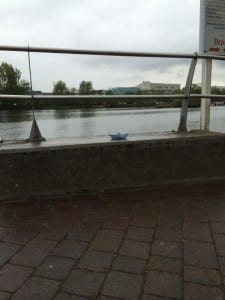
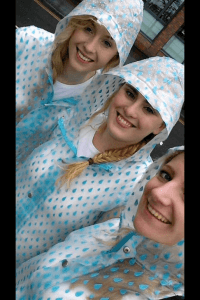
Paper Boat (2015) Against the Flow. [ Performance] Lincoln: Brayford Wharf, 7th May.
Kerry McCarthy, Naomi Jones and Rachel Mudd (2015) Against the Flow. [Perfromance] Lincoln: Brayford Wharf, 7th May.
Ducks (2015) Against the Flow.[Performance] Lincoln: Brayford Wharf, 7th May.
Bibliography
Creasey, J.S. (1967) Brayford Pool Lincoln. Lincoln
Dovey, J. and Fluemont, C. (2012) The Pervasive media cookbook.[Online] Bristol: Available from http://pervasivemediacookbook.com/kitchen/ [Accessed 30 March 2015]
Hahn ,D.(2014) Perfroming Public Spaces, Staging Collective Memory. 50 Kilometres of Files by Rimini Protokoll, 27-38.
Hall, T., Cooper, E., Cunningham, C., Haley, P. (1983) Lincoln’s Waterways – Trail 1. England: Hainton Printing Centre Limited
Haug, H., Kaegi, S. and Wetzel, D. Rimini Protokoll. [Online] Berlin: Available from http://www.rimini-protokoll.de/website/en/projects_date.php [Accessed 30 March 2015]
Laidler, K.J. (1989) Brayford Wharf North: Opportunities for Development. Lincoln.
Lawrence, C. and Hunter, M.(2009) A Hackney 4th of July. [Online] London: Available from http://eprints.lincoln.ac.uk/11846/1/AH4oJRecord.pdf [Accessed 18 May 2015]
Lincoln: The Brayford Study. Edinburgh: Mackenzie and Storrie Ltd
McCarthy, K. (2015) Against The Flow Introduction [Personal Recording] Introducing Against The Flow, 20 March.
Mudd, R. (2015) Against The Flow Interview [telephone call] Conversation with Ron Dadswell, 17 March
Pearson, M.(2007) Carrlands.[online] Cardiff bay: Design Stage. Available from http://www.carrlands.org.uk/default.asp [Accessed 30 March 2015]
Pearson, M. (2010) Site Specific Performance. New York: Palgrave Macmillian.
Sotelo, L. (2010) Looking backwards to walk forward walking, Collective memory and the site of the intercultural in site specific performance. Performance Research, 15(4) 59-69.
Theron, S. (2012) Review. Site Specific Performance, 55(2) 279.
Walker, A.(2012) Brayford Pool: Lincolns Waterfront Through Time. Lincoln: The Survey of Lincoln.University of East London (2008) Ports of Call: Walks of Art at the Royal Docks. [online] London: University of East London. Available From http://www.portsofcall.org.uk/legal.html [Accessed 9th May 2015]
A Journey to Now – Final Blog Submission
Framing Statement
In Anna Birch and Joanne Tomkins introduction they tell us as the readers, that site specific performance is a type of art which “is difficult to define, attempts to pin down a mutually agreed-upon understanding of ‘place’ – in either precise physical or metaphorical terms.” (Birch and Tompkins, 2012, 4). My understanding of a site performance is that it is has to be specific to the place. If the performance can be performed in an alternative location; then it doesn’t meet the requirements for the site. Nevertheless if it does not meet the requirements for the site, than it does not make it a successful performance. Mike Pearson states “At site, many things may be happening: performance may need to establish and proclaim its own presence” (Pearson, 2010, 17). I can agree; as in my performance, I accomplished what I wanted to achieve as I embraced the surroundings which was now included in A Journey to Now. What may happen at the site is unpredictable nonetheless you have to be prepared as it is all included in the performance.
After much speculation, my final site specific piece was centred on my life, walking and my two big toes. A walk structures what we see, walks are fluid and they move us through places, not only physically but mentally too, they allow us to think and remember and go into our own world. Walking triggers feelings. Walking is precious, our feet allow us to do this. Take care of them.
Problematic feet have been a part of my life for the past 6 years. If it wasn’t pain in the souls of my feet, it would be pain in my two big toes. Nevertheless in the last year I discovered that I had the painful condition of ingrown toenails. Unfortunately this caused me to have no choice but to have partial nail surgery. This has triggered a significant amount of change and disruption, to my normal day to day life. Throughout our site specific performance studies, I soon recognised “the individual is challenged to navigate their own journey through the performance event reliant upon a deeply personal form of conceptual and phenomenological engagement” (Hunter, 2015, 474). To have a successful performance you need to connect with the site. I learnt that if you care about your topic and you have a personal connection, you are more than likely going to have a memorable and unique performance. “Memories of this performance will stay with me and be evoked when I walk around” (Hunter, 2015, 473). My piece was real, it had no acting; it was A Journey to Now.
(January 15th 2015, My Left Toe)
Liberation was the stimuli we had been given to create our performance. What did liberation mean? Liberation can be taken down many different pathways. Nonetheless I perceived it as freedom; liberating yourself from an oppressive matter. I have always been extremely embarrassed of my feet condition; I don’t like talking about it and I don’t like people to know about it. This was my truth and I wanted to free myself from these issues. Even though telling stories of my feet will not resolve the problems, sharing them does help.
A Journey to Now was heavily influenced by practitioners such as Carl Lavery autobiographical text – Mourning Walk, Michel de Certeau – Walking in the City and finally Conan Lawrence – Amelie Daems’s Feet.
My site specific location was Lincoln High Street, this fit my performance perfectly. Ever since I joined Lincoln University, I have had ongoing issues with being able to complete simple journeys on foot. I would have to wear flip flops not only summer but winter months too. I could barely walk after my partial nail surgery. The first walk I successfully completed without having to stop, was a 27 minute walk from the top of castle square down to the LPAC. To an audience, this might seem strange but to me that was a journey, I never imagined being able to complete. The site specific performance had to have a connection with the Frequency festival who use techniques such as pervasive media. Taking this in to consideration, I decided on a video piece which was projected in the studio, while I was story telling alongside. Recording a video allowed me to liberate a moment in time, it allowed me to rescue the moment. My performance A Journey to Now took place on the 9th May.
(January 6th 2015, My toes after partial nail surgery)
Analysis of Process
Pervasive media is one of the first topics we looked at during the beginning of our site specific module. “Pervasive Media is Digital Media delivered into the fabric of real life and based on the situational context at the moment of delivery” (Pmstudio.co.uk, 2015). This media concepts allows performance to use different types of technology such as, mobiles, internet, and projectors; to bring images, videos and games to your piece. Media such as this fits perfectly with the liberation theme as there is so much you can do with it and it links perfectly to the frequency brief. The frequency festivals work portrays pervasive media throughout. Pervasive media uses “technology to understand something about the situation and respond based on that information” (Pmstudio.co.uk, 2015). Such as A Journey to Now a pervasive media technique allowed me to capture video graphed moments which I never intended on having in my performance; such as the building works in Lincoln which symbolised the high street needed to be fixed such as my feet. The Poundshop which triggered memories from holidays with my family in Cyprus, the early morning walks I was forced to go on with my uncle between the ages of 7-14. The video helped me capture and remember moments, which allowed me to have greater context in my final performance. Indulging these new and radical forms of pervasive media, mapped changes and helped me enhance an interactive narrative, throughout my site specific performance. Pervasive media as a stimuli allowed me to explore and “understand new forms of collaborative art. (Hales and Kelomees, 2014, 4).
My first solo task was one of Carl Lavery’s 25 instructions. I had chosen instruction 22 “Sit in a park, café or bar and listen to the stories spoken around you” (Lavery, 2005, 236). I chose Costa on triton road, a fairly busy coffee shop. The reason for this; I thought it was interesting to see how humans behaved and to observe and people watch. I believe I could have create a performance about the world and the different lifestyles people live. The different emotions, feelings and atmosphere we as humans can create.
It took me a while to decide on a definite topic for my performance. Nevertheless watching Unfinished Sympathy by Massive Attack and Bitter Sweet Symphony by The Verve gave me the set idea of going ahead with a video performance.
(The Verve, Bitter Sweet Symphony, 2009)
(Massive Attack, Unfinished Symphony, 2009)
Instantly after watching both the videos, it was clear that they were equally going for a similar approach. This was to have the camera shadow the artist walking around the city. I believe these ideas were very clever and thought out, so simple yet so rewarding. Observing the videos you get so much out of them, watching the world go by. Seeing what people get up to in their daily life. Nonetheless this gave me the idea of producing a video performance for my Site project. I thought of the idea to walk down from the top of the high street location to the LPAC. However what I would do different is to not have myself walking in the video, I would rather catch the moments of the public’s daily life. People tell a story with the way they walk and the way they are dressed and the routes they choose to take. I feel as though there is always so much happening on Lincoln High-street as it is so busy, this would be aseptically pleasing for the camera. This would be liberating a moment in time as I will be rescuing moments not just of the public but of the buildings too. It is extremely easy to overlook or lose track of everyday life. The simplest day to day tasks are forgotten. On the other hand, I will also be able to relate this to myself, as I have issues with walking. Ingrown toenails have created a great distress towards my life during university. Creating this journey and recording it will allow me to never forget the moment I was able to free myself from the clutches of my feet and walk from castle square, down Lincoln high street to university.
While reading Michel de Certeau, Walking in the City, I found it absolutely fascinating. De Certeau Walking in the City really relates to the type of work which I was looking at doing. I used this text as inspiration. “Michel de Certeau analyses an aspect of daily urban life. He presents a theory of the city, or rather an ideal for the city, against theories and ideals of urban planners and managers, and to do so, he does not look down at the city as if from a high-rise building – he walks in it” (Certeau, 1988). The best way for me to capture the moments for my performance, is by actually walking the route instead of sitting and observing. Journeys create maps and makes you realise the space that is organised by streets and buildings. To give my performance clarification, I needed to get to know my site better by continuously revisiting the journey that I wanted to create.
Walking at the top of castle square brings back memories of walking on the uneven pebbly pavements in Cyprus. The cobbled streets on steep hill triggers thoughts of the walks I was forced to do with my uncle at 5am. If I could go back, even though walking was not my favourite hobby, I would go on those walks with my Uncle without complaining.
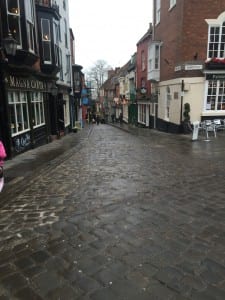
This is where I begin my journey of the walk and reading Amelie Daems’s Feet by Conan Lawrence, makes me wonder how it would feel to do the 20 minute journey bare foot (Lawrence, 2012). Never mind Amelie Daems’s who walked all the way across Belgium taking her four weeks. “Four weeks of walking leave a foil on the sole, tracks to catch up on the journey just made. Grids, contorted boxes, cross-hatchings; knots of repeated pressure, sweat and balancing (walking as a continued attempt to refrain from falling). Toes bunched up, repeatedly curled into or against contours and sleights of land. A heelprint’s finely striated, bonded reply to ground. The body’s isobaric chart tucked out of sight.” (Lawrence, 2012). The walk that Daems’s has accomplished will never leave as the markings on her feet from the performance will never leave her. Yes physically the marks on her feet may leave but some may scar and even if they do vanish she will always be able to remember the effect that walk had on her feet. This could be seen as creating a map on her feet. The markings are creating another journey solely for her feet.
Many people can walk for hours without their feet hurting, getting blisters or cuts however others can’t. Looking at the concrete at the start of my journey, I couldn’t imagine anything worse than walking down it without shoes. The cobbles pressing into feet, especially my feet which are so sensitive will leave a harsh mark. There has been times when I have been out, and have had to take off my shoes from the pain. Unfortunately I would have to walk back home on the concrete and I could feel every grain on the floor. Nevertheless, what I did was wear some uncomfortable sandals not my usual, to walk down the cobble street and by the time I got to the bottom, my feet were throbbing. Not having the comfort of my usual shoes, gave me great pain in my feet. Walking is something which we have to do every day, whether it’s a small journey or a big journey. It’s an important aspect to our daily life’s, we get comfortable and we know what’s best for our feet. The walk Daems’s did in my opinion was a fascinating because I’m sure many people would not be able to complete that journey.
The Idea of Daems’s creating a map on her feet presented myself and my tutor with the idea of map making. Creating a map on the soul of my foot using a representation from the walk I made. I printed out the journey I accomplished on google maps, and asked an audience member to draw the line on my foot, symbolising the scaring from Lincoln High Street.
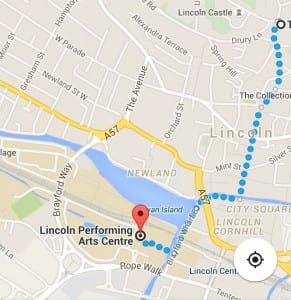
(March 6th 2015, Google Maps – Castle Square via LPAC)
Conan Lawrence piece on Amelie Daems was my biggest influence as I could really relate to her. Even though a 4 week journey across of Belgium is totally different from a 27 minute walk down Lincoln High Street; I can imagine the excruciating pain she was in. Feet are so precious and you need to look after them. I can only sympathise with the agony she must have been in, and I comment her for being so brave. The way Lawrence has used descriptive text to describe Daems experience, has given me the idea to write a performance text for my own story telling alongside my video. This text consisted of when my problems with my feet began, memories of walking and links involving my chosen site. To help me do this, I would frequently take the walk that my site requires. This aided me to get a better feel and understanding of my site. It was stimulating to just walk in silence and observe what was happening around me. Listening to people’s conversation, looking at their facial expressions, just watching the passers go by. The speed of peoples walking, the urgency or the tranquil walks. Observing the buildings and the architecture. The old city known as Lincoln.
(March 8th 2015, Lincoln High Street)
The chapter Mourning Walk by Carl Lavery in the book Walking Writing and Performance, is a special chapter, a very personal chapter about Lavery taking an 18 miles journey to mark the ninth anniversary of his father’s death. At the end of his Journey he performs a ritual in a field. We never find out what that ritual is, whether it was something minimal or something complex. Lavery believed that not everything had to be shared “Certain things are ought to be kept a secret” (Heddon, Lavery and Smith, 2009, 28) . The walk allows Lavery to reminisce and help move him through a hard time. I felt trapped when I couldn’t take the smallest of walks and now that I have accomplished my half an hour journey down Lincoln high street to the studio it has moved me in more ways than one. I will never forget this specific, site specific walk. “Walking is a technique of solitude, a way into reverie. The walker is not a sleepwalker but a daydreamer […] when I walk, I go back and forth in an infinite journey between memory and imagination” (Heddon, Lavery and Smith, 2009, 32).
Lavery’s Mourning Walk inspired me to perform my own rituals alongside my performance. I not only wanted to tell my story but I wanted people to see. My rituals were going to be exactly what I do on a daily basis. I didn’t want to fabricate my performance, I wanted nothing but the truth. My first ritual would be to do my daily stretches on each foot, which helps with my condition of flat feet. My second ritual would be to bathe my feet in warm salt water for five minutes, this helps to soften my toes. My third ritual would be to just simple dry my feet. My fourth ritual would be to cut my toenails to make sure they are kept nice, straight and tidy. My fifth ritual would be to file my toenails. My sixth ritual would be to use my special foot moisturiser, to soften the toes and feet.
After each piece of text is read out from the pieces of paper, I will scrunch them up and throw them towards my shoes; this is to symbolise that I am letting go of those harsh full thoughts and I am starting a fresh. I am letting go of the memories of me not being able to walk and I am going to be writing a new story. That was my past and this is my future. I am liberating myself from the pain and saying goodbye.
Evaluation
My aims for A Journey to Now was to have an intimate performance as this piece is personal to me. It is my truth, and my real story. The reason the audience were set up in a semicircle, was to allow them to be a part of my story. I wanted a minimal number, as I wanted a close relationship between myself and the audience. The video was in silence as I wanted them watch carefully but listen to the words, I had to say. I wanted the focus on the text and my rituals.
Overall, I feel as though the performance went extremely well and I am pleased with the outcome. The initial run through was not the best it could have been as the nerves were getting to me. It was my first ever solo performance, and it was an achievement for me. It has not been easy and I do hope the hard work has paid off. It has been a stressful process, but rewarding process and I have truly relished this module. I have learnt so much about myself, such as I never thought I would have had the confidence to accomplish something like this. Before my friends came I pre-warned them, that I was not too sure if they would get bored or enjoy it. I felt embarrassed, however I was wrong about that. My audience members said that they had great sympathy for me and the pain that I have been through with my feet. They said that, through the performance text they could really appreciate and picture my story. My downfall was that I was nervous at the beginning, and if I was to do it again, I would make sure I’d get rid of that as I know the performance paid off. The reason for my nerves is because, I have never had to perform for half an hour on stage by myself. There is nothing I would change about my setup, next time I would just tell myself to go for it from the start to finish. This has been an amazing experience and I would love to do it again.
Works Cited
Birch, A. and Tompkins, J. (2012). Performing site-specific theatre. Basingstoke: Palgrave Macmillian.
Certeau, M. (1988). The practice of everyday life. Berkeley: University of California Press.
Hales, C. and Kelomees, R. (2014). Expanding practices in audiovisual narrative. Newcastle upon Tyne: Cambridge Scholars Publishing.
Heddon, D., Lavery, C. and Smith, P. (2009). Walking, writing and performance. Bristol: Intellect Books.
Hunter, V. (2015). Moving sites. Abingdon: Routledge.
Lavery, C. (2005). Teaching Performance Studies: 25 instructions for performance in cities. Studies in Theatre and Performance, 25(3), pp.229-238.
Lawrence, C. (2012). Amelie Daems’s feet, Conan Lawrence. [online] walkie-talkie too. Available at: https://walkietalkietoo.wordpress.com/2012/09/18/bare-feet-conan-lawrence/ [Accessed 10 May 2015].
Pearson, M. (2010). Site-specific performance. Houndmills, Basingstoke, Hampshire: Palgrave Macmillan.
Pmstudio.co.uk, (2015). What is Pervasive Media? | pervasive media studio. [online] Available at: http://www.pmstudio.co.uk/pmstudio/what-pervasive-media [Accessed 10 May 2015].
YouTube, (2015). Massive Attack – Unfinished Sympathy. [online] Available at: https://www.youtube.com/watch?v=ZWmrfgj0MZI [Accessed 15 May 2015].
YouTube, (2015). The Verve – Bitter Sweet Symphony. [online] Available at: https://www.youtube.com/watch?v=1lyu1KKwC74 [Accessed 15 May 2015].
A March Against Consumerism
Framing Statement:
The aim of the high street these days is too make consumers spend money; we want to stop this with social interaction by breaking everyday routines even if it is only for a fleeting moment.
The word ‘Liberation’ was the starting block to our performance; we were asked what it meant to us in the context of our site: ‘The High Street’. After discussing the high street with not only our group but with others as well, it became clear that the main aim is to spend money. This led to a discussion on how we could change this, however we knew that we would never put a stop to it outright, this is where the concept of a ‘fleeting moment’ came from . We wanted to create a piece that would not only disrupt the flow of the high street in the moment of interaction but would also make the audience think about it later. This is part of the reason we used simple interactions, ones that people use in everyday life. However the context of the simple interactions, made them feel abnormal. It’s not everyday that you walk through the high street and are confronted by 4 girls wearing ponchos and sunglasses holding giant signs asking to be hugged or give high fives.
Our performance took place on Thursday 7th May between the hours of 11am and 1:30pm, the signs were spread across the length of the high street, we had four in total each had a different message: ‘can we hug?’, ‘can we high five?’, ‘can I compliment you?’ and ‘what would you write?’, these signs were printed on A2 signs that were 3 foot high so could be seen all the way down the high street. The order of the signs was important; we started at the bottom of the high street with the sign that needed the least interaction (compliment) and ending at the top of the high street with the sign that require the most social interaction (what would you write?). The objective of the performance was to allow social interaction, this is why it was imperative that we were inviting, meaning that we had to look happy whilst stood with our signs, this was then juxtaposed every half an hour with the ‘changing of the guard’. Based on the formal ritual performed outside Buckingham Palace, we marched to the stone bow for a rehearsed changing over. This juxtaposition highlighted the fact that it was a performance, and also tied our performance in with work by other performance artists like Andrew Stitt, Gillian Wearing and the work that took place during the Happenings.
Analysis Of Performance:
Our piece took heavy influence from quite a lot of other performance art work. We looked into many different practitioners throughout the module however we were influenced heavily by just a few. Whilst researching the use of signs in site based performance work, we came across a piece of work by Gillian Wearing called signs that say what you want to say and not what someone else wants you to say. It was one of her earlier works and involved members of the public holding up signs that they had written something on. Early on in the process we looked into Wearing’s work, just as inspiration for the audience interaction portion of our project. I personally felt that I was very much the same as Wearing at the beginning of her work; I was nervous about approaching strangers however as Wearing said “once I actually got the statement out… I’d say 85% of the people said yes“ (Wearing,1999,) this was the same with our performance. In test runs, we did it with smaller versions of our signs, people had a tendency to complete the action on the sign when prompted but never really knew why they were doing it. As a group we tried to explain, but as we hadn’t produced a prepared speech the answers varied between performers, which is not something we could afford on the day. The performance’s message about the liberation of consumerism would not be effective if an audience member heard 4 different versions of our aim. This is why we decided early on in the process that we needed a framing statement for the piece, one that as actors, the four of us could learn, and would describe concisely and clearly our aims for the performance.
Drifting was a big part of the whole process, we read sardine street box of tricks, this highlighted the fact that location is important to a performance. ‘you need to be hyper-sensitised to the flows, stories and textures of what is around you’ (Crab man& Signpost, 2011). I use the high street every day and until I did my first drift from St Mary Le Wigford right up to the Cathedral I had never noticed many of the things that it contained. We decided to drift individually before meeting at the bottom of Steep Hill before continuing to the top as a group. The top still being the optional site for our performance at this point. As Lincoln is one of the oldest cities in the country dating back to the roman times there were a lot of interesting things to see, however the thing that struck us most as a group was the misplacement of a single brick in the path. This one brick being slightly out of place highlighted the idea that small changes can make a big difference. The idea that one brick could change the look of the whole street was mesmerizing to me, it made me contemplate the idea of loneliness and how something that has been out-cast can be forgotten about so easily, just like a non-consumer is on the high street.
The process started with exploration on Tim Ettchell’s 8 Fragments, whilst reading this the one that stuck out to us a group the most was observation/ coincidence. In this section Ettchell’s states “we pass each other like objects on a projection line.” (Etchells, 1999, 79). It was after we spent time observing the high street as bystanders we realised how true this was. Lincoln High Street is the epitome of a production line created by large shopping corporations, consumers walk from one to the other rarely stopping, with the one goal, to spend money. This is where the beginnings of our idea came to fruition. We knew we wanted to challenge social stereotypes and defy the rules liberating not only ourselves but the consumer as a whole from the restraints of a consumerist society.
This led to one of our first experiments in our site. We took the idea of a production line and looked at it literally taking inspiration from things like escalators; ‘on an escalator we watch each other, getting closer, and then just as we could speak, or even touch, our eyes drop and the moment passes (Etchell 1999, 79). People passed one another mechanically. We wrote messages such as ‘can we high five?’ on post-it-notes and held them out, whilst traveling in opposite directions to people on the escalators. The aim was to take people out of their comfort zone, it also broke the anonymity people hide behind whilst by themselves when on the high street. By breaking the usual flow of the escalator we changed the function just for a fleeting moment, Pearson states that “In public, we may require a kind of physical restraint, a kind of decorum that allows the mass to function” (Pearson, 2010, 98). By approaching strangers with a request to take part in a simple action that was already familiar to them, we stopped them from being taken out of their comfort zone too much, meaning they were more likely to engage in the practice making audience interaction more likely.
DominqueGent,2015
We not only engaged with the audience we also used observation to look at people on the high street ‘the city was always about glimpsing other lives?’ (Etchell, 1999,79). This is why we used the post-it-notes in order to make snap judgments about members of the public, we documented this through the use of photography much like Gillian Wearing does with her pieces. This task allowed us to look at people we would usually ignore whilst on the high street. What was most interesting about this task is that throughout the whole process we were mostly ignored, people were disinterested in what we were doing choosing instead to carry on with their daily routines. Whilst doing this activity we noticed a man handing out fliers, after watching him for twenty minutes we noticed that nearly everyone that walked passed him ignored him. Due I believe to the fact that on the high street people are pre programmed to believe that everyone is trying to sell them something. This led to the interesting notion of gifts and how that man could have been handing out anything, but as people have a preconceived notion of leaflet givers have ignored his plight to help people. This concept interested us, as we wanted to try and find something that would pull people out of there own worlds for long enough for them to notice their surrounding, and have a chance to change their opinions on the high street and its purpose in modern society.
Although part of the brief for frequency festival is pervasive media we decided it was important to steer intentionally away from it. We noted from our trips to the site that whether it was people making phone calls, sending/receiving texts, listening to music or doing other things, mobile phones have become a staple of modern day life, leading to the lack of attention people pay to one another increasing. During our final performance I had a conversation with a lady who said “I think it is appalling that young people are always on their phones, they are missing everything”. This statement is for the most part true; however it is not just young people technology has also gripped the older generation. Whilst carrying out our first test, I saw an equal number of people over the age of 30 on their phones as I did teenagers. The aim of our piece was to make people notice what was around them, by doing this it was clear that pervasive media was not an option for us to fully reach our goal.
After our first experiment we were quite set on the idea of giving gifts, we then sat down and wrote a list of possible gifts we could give to passers by that would disrupt the flow of their journey, however the act of gift for even a short period of time would then resonate with them for the rest of the day. We then settled on just five that we could take onto the high street in a series of trial runs.
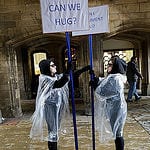
P, Crowe, 2015 Changing of the guard Taken 7th May 2015
We found was that ‘ Can we high-five?’ and ‘Can we hug?’ were by far the most popular. However, the most interesting reaction we got was whilst Dom was holding up the ‘Can I compliment you?’ sign. A boy came over to her and asked a load of questions about what we were doing and why. His response also gave us motivation as it backed up all our thoughts about the piece. “I don’t normally go out of my way to talk to people, but you really interested me and made me want to talk to someone new” . This is the basic idea of our piece, we want to draw people out of their comfort zone and go against the usual practice of the high street.
Emily Cartwright, 2015 signs part 1
Overall this trip allowed us to explore the bottom of the high street and ‘challenge the hegemonic use of the urban space and the audience as a consumer’ (Hancock,2012). The fact that consumers took time out of their day to take part in our experiment. Another thing we found is that a lot of people walked passed and then came back and interacted with us or watched us for a while before interacting.
The hardest part of the process was trying to decide what we wanted to be on the final sign. Looking back at Gillian Wearing’s work in her piece signs that say what you want to say and not what someone else wants you to say, we decided we liked the idea of the audience being able to have their say. Wearing used the idea of confessions on her board, asking people in Trafalgar Square, however she did this project over a long period of time collating hundreds of images, this is not something we had the luxury of being able to do. She also stated that ‘the most important aspect was approaching strangers on the street and the interaction between us’ (Wearing,1999). This perfectly summed up everything we had been trying to achieve with our piece up until this point. However we didn’t believe that the confessions was something that would work with the other signs we had created, it didn’t fit with the idea of gifts that we had been pursuing.
Now that we had decided on the content of three signs we still had one that was blank, so we began to draw comparisons to the Fourth Plinth program, ‘The Fourth Plinth Programme is the most talked about contemporary art prize in the UK. Funded by the Mayor of London and supported by Arts Council England, the programme invites world class artists to make astonishing new works for the centre of the capital city.’(London.gov, 2015) The plinth has been left blank since monetary issues stopped a statue of Henry IV being built there. Since 1988 it has been a site where artists can erect temporary work on the plinth and have their work shown for a certain amount of time. This idea of audience participation and giving the audience a chance to be heard and share their views inspired us to leave one sign blank on one side with the message ‘what would you write’? Anthony Gormley did a similar thing on the plinth as his art work, for every hour for twenty four hours a day Gormley invited members of the public onto the plinth, he stated “It will be an experiment, I imagine that there will be extroverts who will see this as an opportunity to do the biggest party trick ever. But I have no expectations. I would be absolutely happy if somebody got up there with an umbrella and just stood still for an hour. The idea is that this will be a portrait of Britain made out of 2,400 hours of 2,400 people’s lives.” (Sooke, 2009). The idea of the audience getting to be a part of the performance was an interesting concept, and is something we decided needed to be a part of our performance. Although it didn’t have to be as explicit as Wearing’s work it allowed the audience to participate. The question ‘what would you write?’ allowed the audience to be as personal as they wanted, meaning more people were likely to write something down. As it was whiteboard after each ‘changing of the guard’ had taken place the idea was for any signs that had been written to be taken down, so that it was a blank slate for the next performer. However if something was written at the beginning of the thirty minute interval before the change took place, then the performer was to hold the sign with the audience members words on. I think this was an interesting concept as it shows that once it is written it can apply to anyone, the only way you could distinguish between who had written it was the handwriting, which strangers can not identify you with anyway.
Performance Analysis
Politics was always going to be an issue with our piece. Although we didn’t want the piece to be overtly political, anything that is done that goes against the norm that is set by society is always seen as a ‘political movement’. The became more to the fore with our piece especially when we found out the performance day was going to the 7th of May 2015, the date of the General Election. We also found out that you are not allowed to publicly vie for votes in town centers on election day. We were concerned we may have an issue with the fact that our signs were blue and did look slightly like a Conservative banner, this is why we had to monitor the ‘what would you write?’ sign, as any overtly political messages may have caused issues. This being said, we didn’t want to oppress anyone by censoring their free speech, so we decided as long as the comments were not derogatory towards anyone then it should be allowed to be held up.
Overall the performance went better than I could have ever expected, the reactions the signs we’re for the most part positive. The easiest and best to hold up were the ‘can we high five?’ and ‘Can we Hug?’ these created the most response but i believe this is because it didn’t need that much interaction, the audience could take part without having to take too much time out of their day. ‘high five’ also attracted a lot of family groups with children running up to us to give ‘high fives’. we also felt that the weather was going to affect the performance more than it did. During our rehearsals in the high street it rained and the audience stopped interacting, this did make us nervous especially when we saw the weather forecast, however it wasn’t as bad as we thought it was going to be even in the rain passersby still stopped to engage in the performance and ask us what we were doing.
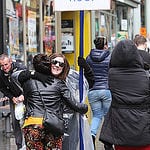
Crowe, P, 2015 Can We Hug Taken 7th May 2015
The costume worked well it kept us looking the same and in unison. However one member of the group did take off their poncho which i feel did detract from the performance slightly as it stopped us all looking the same. The fact that the ponchos were clear and the other three members of the group kept theirs on did soften the blow slightly.
Site specific performance has taught me that performance doesn’t need to take place on a stage, ‘all the worlds a stage’ (shakespeare, 1623) I now have an appreciation for the use of site and space as an influence for performance, Site specific performance allows you to discover a site making a performance that has more depth as it takes inspiration from the surroundings and the history of your site.
Works Cited
Etchells, T. (1999) Certain Fragements. London: Routledge.
Govan, (2007). Between Routes and Roots. Performance, Place and Diaspora. 136-143.
Hancock,S (2012) Contemporary Walking Practices and the Situationist International: The Politics of Perambulating the Boundaries Between Art and Life. Contempory Theatre Review, Vol. 22 Issue 2, p237-250. 14p.
London.Gov (2009) Fourth Plinth [online] https://www.london.gov.uk/priorities/arts-culture/fourth-plinth[accessed on 10th may 2015]
Persighetti, S. and Smith, P. (2011) A Sardine Street Box of Tricks. Plymouth: Blurb Inc.
Sooke, A. (2009) Antony Gormley’s Fourth Plinth, Trafalgar Square. The Telegraph, 26 Feb. [Accessed Online] at: http://www.telegraph.co.uk/culture/4838343/Antony-Gormleys-Fourth-Plinth-Trafalgar-Square.html
Apted,M, Fergurson, R. De Salvo, D. (1999) Gillian Wearing. London: Phaidon Press.
emily cartwright (2015) signs 1 [Online Video] Available from https://www.youtube.com/watch?v=lSb6UobOszg [accessed 12 May 2015]
Dominique Gent (2015) Site Specific Observation Video [Online Video] https://youtu.be/CVtcgAIdgnc [accessed on 12th may 2015]
P, Crowe (2015) Lincoln performing arts Flickr
The Guardian (2015) The Fourth Plinth: the story so far [Online] http://www.theguardian.com/artanddesign/2009/jul/07/fourth-plinth-one-and-other [Accessed 13th may 2015]
Tate, (1993) Gillian Wearing OBE. [Online image] London: Tate. Available from: http://www.tate.org.uk/art/artworks/wearing-im-desperate-p78348
Passages – A Site-Specific piece
Passages
A beginning passage
‘Passages’ was a site-specific performance performed on the 9th of April 2015 within Studio 1 of the LPAC .The piece concerned itself with St Peters Passage, an alleyway just off the high street in Lincoln. While not performed directly at the site, mainly due to health and safety, the performance authentically brought St Peters Passage to life within the studio through additional means. The main features of the piece were 3D projection, numerous down-lit items and recorded sound such as a voiceover and a piece of music. Overall, the piece lasted around 30 minutes and involved a total audience of fifteen people, all of whom wore a pair of glasses to access the 3D video. By looking at the practitioner Fiona Templeton, I was able to address ‘the limits of work and site’ (Kaye, 2003, 199) when performing a site piece inside. This ultimately permitted the audience to start a journey through ‘obscure parts of the city’ (Templeton, 1990, ix) which they would usually never do, such as that of St Peters Passage.
There were multiple aims of the piece. One was to inform the audience of activities such as homelessness and drug use that went on down St Peters Passage. The other to draw their attention to the strange and significant markings which were presnt down the passage such as the brown hand prints on the walls. The piece was also used to show the audience that we all, be it literal or metaphorically, have a St Peters Passage within our lives – a place that we all fear to enter or revisit but somehow we are always drawn back.
By looking into multiple definitions of the word “passage”, an example being a journey by ship, and by employing various objects (which in themselves were passages into texts) I was able to emphasise the notion that we all have a St Peters Passage which is linked through our other passages in life. By taking the audience down 3D version of St Peters Passage, I attempted revealed the various encounters I experienced down there. A prime example of this was coming across a homeless man in a sleeping bag who began to shout frantically, but whether it was at me or the wall is in itself an entirely different matter. I portrayed this within the piece by lying in a sleeping bag while the video was playing and talking loudly at the audience. Additionally, I used the piece to reveal personal details of my life such as stories from my dad’s work. By taking influence from many practitioners and performances such as Georges Perec, Penelope Retold (Horton, 2015), Radio Ballet Leipzig (Radiodispersion, 2008) and the theatre group Seven Sisters, I able to effectively create my piece and thus portray it authentically.
An insite into the development of my piece
The brief given to us at the start of the module explained that we had to devise a site piece based on Lincoln’s high street involving the concepts of liberation and pervasive media. I began to read numerous texts to try and understand the ideas in order to develop a performance.
Mike Pearson’s Site-Specific Performance discusses the differences between a site performance and a piece set within an auditorium. Pearson’s list allowed me to understand the alterations between these types of theatre and thus gain an insight into the world of site. Pearson states that within ‘the auditorium the scene is singular’ (Pearson, 2010, p.17) whereas at the site ‘the prospect is complex unless otherwise framed’ (Pearson, 2010, p.17). This in itself is quite interesting as Pearson’s statement implies that a site performance within an auditorium would not be effective.
Before reading Janne Tapper’s article Pervasive Games (Tapper, 2014), my perception of pervasive media and how it is utilised within site-specific performance was non-existent. How could pervasive media be utilised to interest an audience? What techniques needed to be mastered in order to create a compelling piece? All became clear after reading the article. The referral to a piece ‘played on the streets of Tel-Aviv, Israel, in the middle of a busy intersection’ (Tapper, 2014, 151) where ‘one character was shot and killed, and the body was taken and placed in a dumpster’ (Tapper, 2014, 151) alerted me to how powerful a performance can be. The simplicty inspired me to investigate just how simple a performance could be. Regarding my performance, I knew that this type of work would not work in Lincoln. The risks involved with doing this type of piece were high and thus would be a danger to myself and the wellbeing of the Lincoln public. Overall, the main principle I took from this was how simple a site performance could be while still being effective.
After delving into the world of site, I decided to investigate Lincoln’s high-street to gain ideas for my piece. I scouted the area and searched for hidden alleyways while also paying attention to the buildings and streets. What I discovered was astonishing. While I regularly use the high street for consumerist needs, I never truly noticed the architecture of the buildings and the atmosphere they generate. An example of this was Jews Court. While paying special attention to this building, I felt transported back into the middle ages and thus compelled to research it further and perhaps pursue it for my project. Scouting Lincoln’s high street exhibited to me that items like smart phones distract us from our surroundings and prevent us from experiencing our cities true atmospheres.
After my exploration of the high street, I extended my research by looking around the Lincoln collection. I discovered some useful things in relation to how the high street of Lincoln has changed over the years. From Roman to Anglo-Saxon culture, Lincoln’s high street has vastly changed. From this research, I wanted to further act on the idea of Jews Court while also adding the ancient folklore of Lincoln which I discovered from in the museum.
While researching and developing ideas for the piece, I looked into the Radio Ballet Leipzig (Radiodispersion, 2008) and discovered that the use of an mp3 player within a performance could generate a shift in power during social situations. For example, within the video the majority of people were “actors” whose presence outnumbered the non-participating public. The shift in power towards the “actors” forced those who were not participating to become the minority. Comparing this to Mike Pearson’s Site-Specific Performance (Pearson, 2010), it is clear that this is an example of ‘They go there, you and I do not’ (Pearson, 2010, 24). The creators of the piece used an mp3 device that didn’t require their presence to alter the ‘physical stances and body attitudes’ (Pearson, 2010, 24) of participants in social situations. It encouraged them ‘to touch and smell and listen as much as look’ (Pearson, 2010, 25) in a way which opposed typical social norms. This use of an mp3 provoked my interest because it revealed that a piece can be effective even if I was not present.
From my research I had a faint idea about the direction my performance was heading. I was considering using a simple audio tour to construct a narrative focusing on Jews Court. However, all this changed after a workshop which introduced the concepts of QR codes. The simple idea of placing QR codes around the high street grasped my attention. This is because a ‘user would scan the code and gain access to a variety of information, from textual information and URLs, to contact information that can initiate a text message or phone call’ (Kelly Schultz, 2013, 207). This idea was imple yet effective. I was struck by the notion of a compelling narrative being constructed through placing a QR code at Jews Court.
During one workshop we were instructed to create a three minute piece focusing on a section of Lincoln’s high street. While at first I considered further exploring Jews Court, I decided to investigate St Peters Passage. During my investigation throughout the city, the passage had fascinated me. The initial discovery of this alley was astonishing because while I have walked past it numerous times, I never noticed it. However, the most peculiar aspect of this location was the irony surrounding it. The fact that it is named after Saint Peter, the Saint who holds the keys to heaven, implies that this alleyway is a metaphorical gateway to heaven. On the contrary, the passage itself is dark and moody and is scattered with beer cans, cigarette ends and a ragged sleeping bag. Therefore, with this irony in mind, I decided to portray a story of a homeless man who lives within the passage. To do this, I filmed the location at night and wrote a monologue. By placing this on YouTube, I created a QR code and placed it at the entrance to the passage. The audience could then access this and watch the story unveil before them without having to ascend down the alley. Taking influence from the play ‘I Wish I Was Lonely’ (Walker and Thorpe, 2015), I intended to use the piece to criticise society and the way in which people neglect their surroundings through their mobile phones.
After this experiment, I decided to create a piece on St Peters Passage rather than Jews court. However, instead of using QR codes to show information of the passage, I decided to film the alley with a 3D camera and relocate it to a studio. This is due to two reasons. One was because I felt that brining an audience down the passage at night would not have been adequate as it is unsafe. The other is that I believed placing an audience in a dark, atmospheric studio while watching the passage unveil before them in 3D is more effective than having an audience walk down the alley in a large group.
At first I had the idea, with help from my tutor, that I would be seated within a sleeping bag throughout the performance. This was based on an experience I had down the passage with a man in a sleeping bag shouting. But I felt that remaining solely in this sleeping bag would not be effective for the overall performance. Therefore, I developed the idea of walking around the space with the 3D projection playing behind me in order to create the atmosphere of St Peters Passage. However, I still felt that something was missing. There was still something that needed to be added.
I then began to look at various definitions of the word “passage” which prompted me to decide that the structure of the performance would revolve around these definitions. An example of this is a definition of ‘a journey by sea or air’ (Pearsall et al, 2005, 1285). In regards to this specific definition, I wrote a text based on the North West passage ventures of John Franklin which involved the concepts of distress and despair, something which St Peters Passage reminded me of.
After much exploration, I also decided to add a passage based on the work of Georges Perec and his book An attempt at exhausting a place in Paris (Perec, 2010). Throughout the book, Perec describes in detail events which unfolded in a specific location in Paris over three days. An instance of this is Perec constantly noting the passing of buses, which he does so frequently that he states ‘I’ve lost all interest in them’ (Perec, 2010, 29). The detail which Perec describes this part of Paris was something I capitalised on. Perec began to notice things which aren’t usually noticed such as the ‘slight change in the light’ (Perec, 2010, 36). I felt that this amount of detail could alert the audience to the little nooks and crannies of St Peters passage which would give them a more diverse and intricate insight into the location.
Another key addition which was added was having ten objects from St Peters passage triggering the speeches when they were picked up. This directly linked the site to the studio as the objects have been in the passage’s environment and have gained its traits. While I bought a sleeping bag online, I decided to sit within it in St Peters Passage in order to give it markings from the alley (see image below). I initially had the idea of saying the texts randomly so that during the performance it was unpredictable to both me and the audience. However, after considerable thought, I believed that following a structure of items and spoken texts would better serve the piece. From then on I began experimenting with various writing techniques and topics, ranging from writing my own perception of the alley to adapting the definition of a passport.
Over the course of the next few weeks I began to think of more items and passages to use, a key example being an old boot from my fathers work. While this item didn’t directly link to St Peters Passage, the boot was a passage into a personal story regarding an event when I was young. This, I felt, allowed the piece to be more authentic and portray the notion that all our memories are a passage to our own versions of St Peters Passage.
Because the passage reminded me of the underworld, I decided to involve a piece music that linked to this concept. The underworld is known for the myth of Orpheus and Eurydice, a tale involving love and tragedy. After extensive research into this myth, I decided to a spoken passage based on the myth. The music would initially be played at the end of the piece, but after much playing around, I decided to include it twice. Instead of using the actual names from the myth, I decided to switch them with names that are significant to me. I found the concept of Orpheus walking through the underworld and being unable to look back or he would lose Eurydice forever fascinating. It reminded me of St Peters Passage in the fact that one does not feel compelled to look back due to the possibility of there being danger but, like Orpheus, one always does.
My performance further gained inspiration from the play Penelope Retold (Horton, 2015), a solo piece depicting the life of Odysseus’s wife during his absence. The way in which the actress, Caroline Horton, switched from different personas was something I utilised within my performance during the speeches. For example, her sudden change from happiness to melancholy was something I took inspiration from during my rendition of the Perec speech.
I also began looking into the work of the theatre group Seven Sisters who utilise sound and video within their projects to give the audience an unforgettable experience. While their project Atalanta (Seven Sisters Group, 2010) used video and sound in a different way to how I wished to execute them, their use of these techniques regarding Greek mythology inspired me further emphasise these aspects within my performance. For example, while filming the 3D video, I and my tutor decided to record my decent down the passage and with him following me with the camera. This linked to Greek mythology, in a similar way to Seven Sisters, as it resembled Orpheus walking through the underworld and the camera signifying Eurydice trailing behind.
With the performance looming, I began to focus solely on the performance and how it could be improved. Since all the texts were written and chosen, I only had to make a few edits regarding their content. However, there were several changes to the order of the texts and the objects. For example, the text based on the expeditions of Franklin through the North West passage was initially going to be performed at the end of the piece. However, after a great deal of trail and error, this section was moved to the beginning as I felt its dramatic line “pray for safe passage” would greatly benefit the piece at the start rather than at the end.
One last final passage
When the audience entered the studio and were seated, the lights immediately faded down and the objects became visible through dim lighting. This immediately created an apprehensive atmosphere which would be present throughout the rest of the performance. After remaining away from the audience’s sight for around thirty seconds, I walked into the space and began. The first two spoken passages were not accompanied by a video or voice over but when the second passage was finished, the lights snapped out and a recorded sound of the Odyssey began to play. When the voiceover had finished, the video began and for the rest of the piece I interacted with numerous items which prompted the rest of the spoken passages. During the performance, a piano instrumental from Gluck’s Orpheus and Eurydice (Adagietto, 2014) was used twice: once during the transition between the vodka bottle and McDonald’s carton and the other at the end of the performance when the audience were sat in the dark. Regarding audience interaction, the most significant example of this was at the end during my showing of the stone. An audience member took the stone out of my hand to examine it which forced me to improvise taking it back. This was done by grabbing it from another audience member during the execution of a line in order to make it appear genuine.
Overall, I feel that the performance went far better than I ever expected. While I anticipated some degree of positive feedback, I was overwhelmed by the acclaim that numerous audience members presented me with. A significant example of this was the piece being offered a place within Frequency Festival 2015 which involves me gaining a professional acting credit. I was so proud when this offer was presented to me and I am still in shock now. Ultimately, this shows that my piece was positively received and that it had a significant impact upon the audience. As well as this, I was told that my piece had meant something personal to an audience member, another thing that I still can not believe. This is far greater than I ever imagined my performance to be received like and the fact that it has done so has given me great honour. One audience member, David Turner, was interviewed by myself after the performance in order to get an accurate opinion of the piece. He said that ‘the 3D effect didn’t work for me, however despite this, it didn’t distract from the performance. I feel that the overlapping images gave off an almost dream like vision of the underworld as if I was following the faceless man deeper into the pits of hell’ (Turner, 2015). While it is clear that at first the 3D projection being unable to work is a weakness, his comments ultimately show that it was in-fact a strength. This is because David was able to gain a perspective the rest of the audience and I would never have had when seeing the 3D video work properly.
I believe that a major weakness within the performance was a few stumbles in my delivery, though no one seemed to have picked up on this. If I was to do this performance again, which I hopefully will at Frequency, I will work even more tirelessly on pronunciation so that it appears as professional as possible. In contrast, I believe that the greatest strength was the mix of the items, lighting and 3D footage which gave the piece an authentic feel and thus gave the audience an extraordinary experience.
Bibliography
Adagietto (2014), Gluck – Melody, Dance of the Blessed Spirits “Orfeo Ed Euridice” (Orfeo’s Death) | Alexandre Tharaud [online video] Available from https://www.youtube.com/watch?v=63j3ssQu_X8 [Accessed 2 April 2015].
Elizaaaaax (2015), Site Specific – St Peters Passage [online video] Available from https://www.youtube.com/watch?v=ChKQyF0ZAPw [Accessed 13 February 2015].
Horton, C. (2015) Penelope Retold. [Performance] Lucy Doherty (dir.) Lincoln: Lincoln Performing Arts Centre, 20 March.
Kaye, N. (2003) Site-Specific Art. London: Routledge.
Kelly Schultz, M. (2013) A case study on the appropriateness of using quick response (QR) codes in libraries and museums. Library & Information Science Research, 35 (3) 207-215. Available from http://www.sciencedirect.com/science/article/pii/S0740818813000315# [Accessed 12 March 2015].
Pearsall, J., Hanks, P., Soanes, C. and Stevenson, A. (eds.) (2005) Oxford Dictionary of English. Oxford: Oxford University Press.
Pearson, M. (2010) Site Specific Performance. Basingstoke: Palgrave Macmillan.
Perec, G. (2010) An Attempt At Exhausting A Place In Paris. Translated from French by Marc Lowenthal. Cambridge: Wakefield Press.
Radiodispersion (2008), Radio Ballet Leipzig Main station Part 1 [online video] Available from https://www.youtube.com/watch?v=qI3pfa5QNZI [Accessed 10 February 2015].
Seven Sisters Group. (23 July 2010) Atalanta. [performance] Seven Sisters Group (Dir.) Oxford: Ashmoleon Museum.
Tapper, J. (2014) Pervasive Games: Representations of Existential In-Between-Ness.Themes in Theatre, 8, 143-161.
Templeton, F. (1990) YOU – The City. New York: Rood Books.
Turner, D. Questions about the performance. [interview] Interviewed by Joe Facer, 9 May.
Walker, H. J. and Thorpe, C. (2015) I Wish I Was Lonely. [performance] Hannah Jane Walker and Chris Thorpe (dir.) Lincoln: Lincoln Performing Arts Centre, 11 February.
All images belong to Joe Facer.
Questioning Retail – Charlotte Spragg
Framing Statement
Our process was highly controlled by the influences that we had. Due to the fact that we were not only being assessed for our university course, but also possibly being picked for Frequency Festival in October 2015, we had to take into consideration Frequency’s brief too. Frequency Festival saw fit that this year’s theme would be “liberation, as part of the celebrations of the 800th anniversary of the signing of Magna Carta” (Visitlincoln, 2015).
Our performance Questioning Retail, which was a play on the original name of QR codes, was created around this theme to liberate our audience from consumerism. Our piece was based in Lincoln High Street, between the hours of 9am and 5pm on the 7th of May. During our piece, we were stood in the High Street, wearing QR codes on t-shirts and handing out flyers. On these flyers we had a range of QR codes that took our audience to a series of websites, YouTube videos, texts, etc. Having this kind of content in our QR codes allowed us to explore such things as, the process of our performance, the history of Lincoln High Street, social interaction in the High Street, the Economy and the environment. Flyering allowed us to create a performance, where by the naked eye we looked like annoying, everyday promoters, but in reality, we were actually trying to accomplish the opposite, and stop our audience from the consumerism for a moment.
Using our stimulus ‘liberation’, we were attempting to disrupt the every day congestion of the high street, even if it was just for a moment. We wanted to do this so that we would liberate our audience from the consumerist society that they live in. Therefore, disrupting the flow of ‘cattle’ for a small amount of time, to make them question themselves, and the consumerist site that they shop in. Part of Frequency’s brief was that we also had to incorporate pervasive media into our performance; this was why we chose to use QR codes. We wanted something that would catch an audience members eye, and make them look long enough to want to scan our t-shirts. By having large QR codes on our t shirts allowed us, as a group, to look different to the every day high street user. Although our look was that of a promoter, our content was a complete juxtaposition of this. The content on our t shirts and flyers was made to surprise our participants, for example, QR codes have “increasingly been used as a marketing tool” (marketingdonut, 2015). However, we wanted to change this and use QR codes against their original concept. We wanted to essentially question retail with them.
Analysis of Process
“Contrary to popular belief, breakthrough ideas don’t always come out of the blue like a sudden stroke of lightning” (James, 2014). This statement proved true to us during our process, as many of our ideas were stopped by obstacles.
When starting site specific, I didn’t really know what to expect. I had asked a few third years for their feelings on the subject, and I received many mixed opinions back. However, after a lesson on pervasive media and an exciting workshop with Wes, I started to understand what Site Specific actually was. Our workshop with Wes was a new and interesting way to look at performance. He showed us a software called MaKey MaKey which really interested me. Through this, Wes showed us how to make music with banana’s. Through the use of the bananas linked to the MaKey MaKey software, you could create music just like a keyboard. After the lesson, I went home and had a look at this YouTube clip:
It was amazing what you could do with a simple bit of software. During this workshop with Wes, we learnt about QR codes. All five of us had seen them before, mostly used for marketing purposes such as at the bottom of posters or on the back of McDonald’s cups, etc. However, none of us had made one before. Wes showed us how to create them, explaining that we could put any kind of content in them whether it be a URL, a piece of text or an image. Using the techniques that we had learnt with Wes we went away to think about our performance. At this point we had three separate ideas.
Our three ideas.
Our first idea was driven by Michael Pinchbecks’ Sit with me for a moment and remember.
This inspired us to think about creating a piece of work in a performance space, which would be situated in Lincoln High Street, but would aim to take a participant out of that environment. Michael Pinchbecks’ performance inspired this, as his idea to invite a participant to “sit on the bench for five minutes to listen to a recording that reflects on what it means to sit for a moment and remember.” (wordofwarning, 2015) was very inspirational. We liked the idea of taking a participant out of their surroundings via the use of an audio clip. After listening to Pinchbecks’ audio track, I decided to explore the high street for a while to study the general public. While doing this I found that many people walked with a sense of purpose, not even taking a second look at the others around them, while others buried their faces in their phones and stayed disconnected from the rest of the world. Our group collaborated during the week, via Facebook. We spoke about the idea and our research, we read into Carl Lavery’s 25 Instructions for performance in cities, finding that his seventeenth instruction was to “create a forest in the city”(Lavery, 2005, 236). We wanted to create something that would take a participant out of the consumerist area and put them in a completely juxtaposing place. We wanted to create an instillation of an island which would include two deck chairs, where a participant would join one of us and have a conversation.
Our second idea consisted of using the MaKey MaKey software to create a performance, whereby the participants could touch our hands via the use of something, for example a high five. This would then project our content onto a wall. However, this idea was quickly scrapped as we would have needed an indoor space such as a small shop or a studio.
Finally, our last idea excited us all with the possibility that we had found a solid idea for our performance. We looked into using QR codes and the content in which we could put in them. After much deliberation we came across the idea to have two QR codes each, one on both the back and front of our tshirts. The problem that we were having was what to put into the QR codes. After deciding to choose the QR code idea over the first two, we started to think about the content.
When initially visiting our potential sites; the Lincoln High Street and the Brayford; two very different and contrasting places. Many thoughts and inspirations developed from these sites. Thus starting my initial process. I started by visiting the busy Lincoln High street, observing the busy hustle and bustle of passersby. Too busy with their own little worlds to notice others around them, the cars rushing about to and from different places on and around the high street.
Therefore “the city becomes the location of performance. Performance serves to present recognisable places in unfamiliar ways, from unexpected perspectives. And to reveal unfamiliar locales: rarely visited but just adjacent to the flow of everyday life” (Pearson, 2010, 41). All that came to mind when observing this was how busy it was and how nothing stopped, people lost in a sea of many others driven by their own paths. As a response to this, our group decided that we would video them at peak times during the day. The six places that we chose to video, were places that we felt that people seem to be most oblivious to the happenings around them. Places that even we ourselves, would blend into our surroundings. Filming in Time Lapse allowed us to speed these busy places up and show just how many people walk/ drive through these places in a short amount of time. When looking back at the video now, it allows us to imagine the Lincoln high street fifty of sixty years ago. It allows us to see the metaphorical ghosts of how many people have walked those streets in the past years. Pearson states in his book “I evoke this place fifty years ago: performance as a lens or filter, residing exactly over the current everyday” (Pearson, 2010, 55). In contrast to this site was our other potential site, The Brayford. To many people passing this waterfront it’s just water, boats and swans. To me however, the Brayford is a place where I can think about home. I get a strange nostalgic feeling from this particular waterfront; it takes me back to times when I am home with my family. When looking at the Brayford I get a sense of nostalgia from the water. I remember my family and I feel a longing to see them. Both sites were very contrasting and different. However, we decided that we could use both of the sites in a unique way. We decided that we would wear tshirts with QR codes on them. Originally we wanted the QR codes to be of things in the city that remind us of memories etc, due to personal reflections and feelings from our sites. This would allow us to work around both sites, showing potential audience the thoughts and different perspectives of these two very different places that they take for granted every day. We got the idea to do personal stories from the performance I Wish I Was Lonely.
This performance was about technology and how everyone is so busy in their own little bubbles, on their phones etc. However, the performance was broken down with true stories. This influenced our final piece because we liked how the audience could be invited to use their technology and scan us.
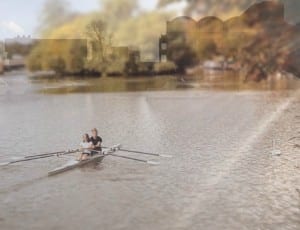
– Superimposed picture of the River Witham (Brayford, Lincoln) and the River Great Ouse (Bedford) with me rowing.
Finally, we came up with a solid idea for our performance. I looked back at Carl Lavery’s 25 Instructions for performance in cities as I had remembered seeing his twenty-first instruction. “Decorate a prominent multi-storey car park with wallpaper”(Lavery, 2005, 236). After I spoke to the group about my findings, we planned to create a piece of instillation which we would put up on a wall in the high street. On the day we planned to create QR codes via the use of a laptop and a printer. We wanted to fill the content of our QR’s with our process, history of Lincoln High Street, social interaction in the High Street, the Economy and the environment. By using a durational performance, we wanted to create a piece of art that would draw our audience from their consumerist high street and make them stop and look for a while. When we had decided on what we were to create, we set about looking for places to put up our instillation.
Straight away we found a prefect location for our instillation on speakers corner. We called the number on the side of the building and were immediately tossed between the council and the Phoenix Health Centre. We were so close to finding the perfect place for our performance, but soon we were told that we were unable to use the building.
We searched for another building in which we would be able to create our performance. After a couple of days of looking, we came across the wall owned by M&S. We were excited as this wall was huge in height, and although off of the public high street slightly, it would still have caught their eyes. We spoke to M&S, asking if we could use their wall. However, after an email back from them, our excitement was once again shot down. We had no where to put our instillation.
After speaking to Conan about the unlikelihood of finding another wall in the High Street, we thought about trying to change our piece.
How could we do something similar, yet not use a wall?
Finally we answered this question by coming up with the QR code flyers. This allowed us to forget the stress of finding a wall and let us focus on the content in which we wanted to fill our QR codes with.
We already knew what we wanted our content to be, this allowed us to set out creating it. As our original idea with the QR codes was to create an art installation live in the high street, I decided that showing the process would allow the audience to seem more involved, and it also allowed them to see the progression of the piece. Even when the idea changed it was still relevant to show the audience the way that we came up with the idea, particularly as we are possibly the first performance group to use QR codes.
Even during our performance, I stuck to the process of our piece. I did this via the use of a live Twitter feed. This allowed us to create a constant update on how our team was developing even through the duration of our performance.
Performance Evaluation
As a result of our performance, Questioning Retail, we found that despite our original worries about audience members not taking part, we were actually overwhelmed by the amount of participants that actually did. Even though our original concept of an instillation didn’t go to plan, our performance seemed to work better than we had wished.
To attract our audiences attention originally, we would ask them one of the following questions:
- Do you have a smart phone?
- Do you know what this is? (We would then point to our t-shirts)
- Do you have a QR code reader?
I chose to address our audience with the question ‘Do you have a smart phone?’ as according to statistics “the number of smart phone owners has reached 72 per cent in the UK” (Mobilemarketing, 2013). When participants said that they did have a smart phone, we asked them if they would like to take part in our performance. We then offered them a flyer containing a QR code. Throughout the day, we had several different reactions to this; these included a mixture of feedback’s, mostly being positive however.
Although we got many people purposely avoiding us, for example:
We did however, get people who stopped and listening to what we had to say:
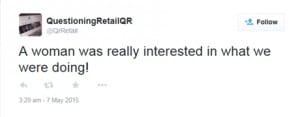
Our Twitter page live feeding the process of the day.
A lot of people simply took a leaflet and left, however there were a few who embraced us with conversation. For example, a man in a tweed jacket stopped to listen to what I had to say. He was so interested that he took a flyer from me, folded it and put it into his wallet, saying that he would get his son to scan it for him to view later. It was people like him that made us realise that our performance was actually functioning in the way that we had planned.
After we spoke to Conan and Wes about our performance, the question we additional addressed our participants with had somewhat changed, from ‘Do you have a smart phone?’ to ‘We shop too much’. This change of dialogue, although we felt it was less approachable and a little bit more oppressive, it appeared to interest participants in our work and was direct into the point of our piece.
Overall, if we were to perform this piece again, we said that we would like to have had a live process on the day. By asking participants to put their own comments/thoughts into a QR code we could have printed them onto paper and handed those out as flyers too.
Although this would have been effective, I feel that our performance allowed us to do what we originally set out to do, which was to stop our audience in their consumerist tracks.
References
Howell, A. (1999) The Analysis of Performance Art: A Guide to its Theory and Practice. Wiltshire: Antony Rowe Ltd.
James, G (2014) How to Come Up With a Breakthrough Idea. [online] Available from: http://www.inc.com/geoffrey-james/how-to-have-a-breakthrough-idea.html [Accessed 13th May 2015]
Lavery, C. (2005) Teaching Performance Studies: 25 instructions for performance in cities. Studies in Theatre and Performance, vol 25, no. 3
Marketingdonut. (2015) Q&A: Mobile marketing with QR codes. [online] Available from: http://www.marketingdonut.co.uk/marketing/direct-marketing/q-a-mobile-marketing-with-qr-codes [Accessed 13th May 2015]
Mobilemarketing. (2013) 7 in 10 People in the UK Now Own a Smart phone. [online] Available from: http://mobilemarketingmagazine.com/7-10-people-uk-now-own-smartphone/ [Accessed 13th May 2015]
Pearson, Mike. Site-Specific Performance. Houndmills, Basingstoke, Hampshire: Palgrave Macmillan, 2010. Print.
Visitlincoln. (2015) Frequency Festival of Digital Culture 2015. [online] Available from: http://www.visitlincoln.com/whats-on/frequency-2015 [Accessed 13th May 2015]
Wordofwarning. (2015) Michael Pinchbeck: Sit with me for a moment and remember. [online] Available from: http://www.wordofwarning.org/archive/2012-hazard/pinchbeck/index.html [Accessed 13th May 2015]
